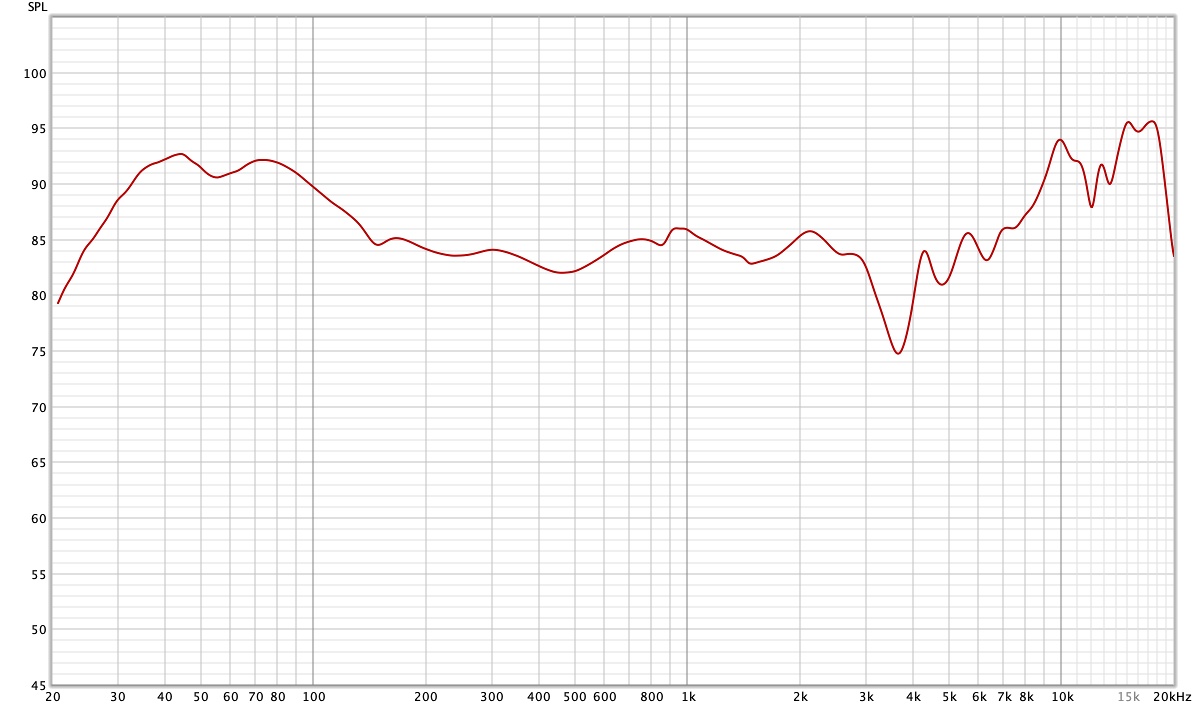The sound signature can vary greatly from one helmet to another. However, this data is quite simple to establish thanks to the response curve. At a glance, it allows you to guess more or less how a pair of headphones sounds and therefore whether you will like to listen to such headphones or earphones. Bass, midrange, treble, fundamental frequencies and harmonics, here is what you need to know to appreciate the signature of headphones or earphones.

The Audio-Technica ATH-M50xBT2 headphones // Source: Audio-Technica
The sound signature of a loudspeaker, headphones or earphones is always complex to describe, as its characteristics are numerous and the fruit of the listener’s personal impressions. However, there is a simple way to materialize a sound signature, through a graphic representation: it is the frequency response curve.
Beforehand, it is important to remember that the sound we hear is nothing other than the vibrations of the air that surrounds us, pressurized by a mechanical force. The higher the pitch of a sound, the more vibrations there are. To measure them, we use a unit of frequency: the Hertz. A sound with a frequency of 82 Hz — the vibration of the thickest string of a guitar — repeats itself 82 times per second.
The range of audible frequencies of the human ear
Our ear is able to hear a spectrum of frequencies between approximately 20 Hz and 20,000 Hz, 20 Hz corresponding to the lowest sound and 20,000 Hz to the highest sound. Below and above, we will talk about infrasound and ultrasound, inaudible to the human ear. To easily refer to the different portions of this sound spectrum, it is customary to divide it into three frequency ranges: these are the famous low, medium and high registers. The low register commonly covers the range from 20Hz to 200Hz, the middle register that from 200Hz to 5000Hz and the high register from 5000 Hz to 20,000 Hz.
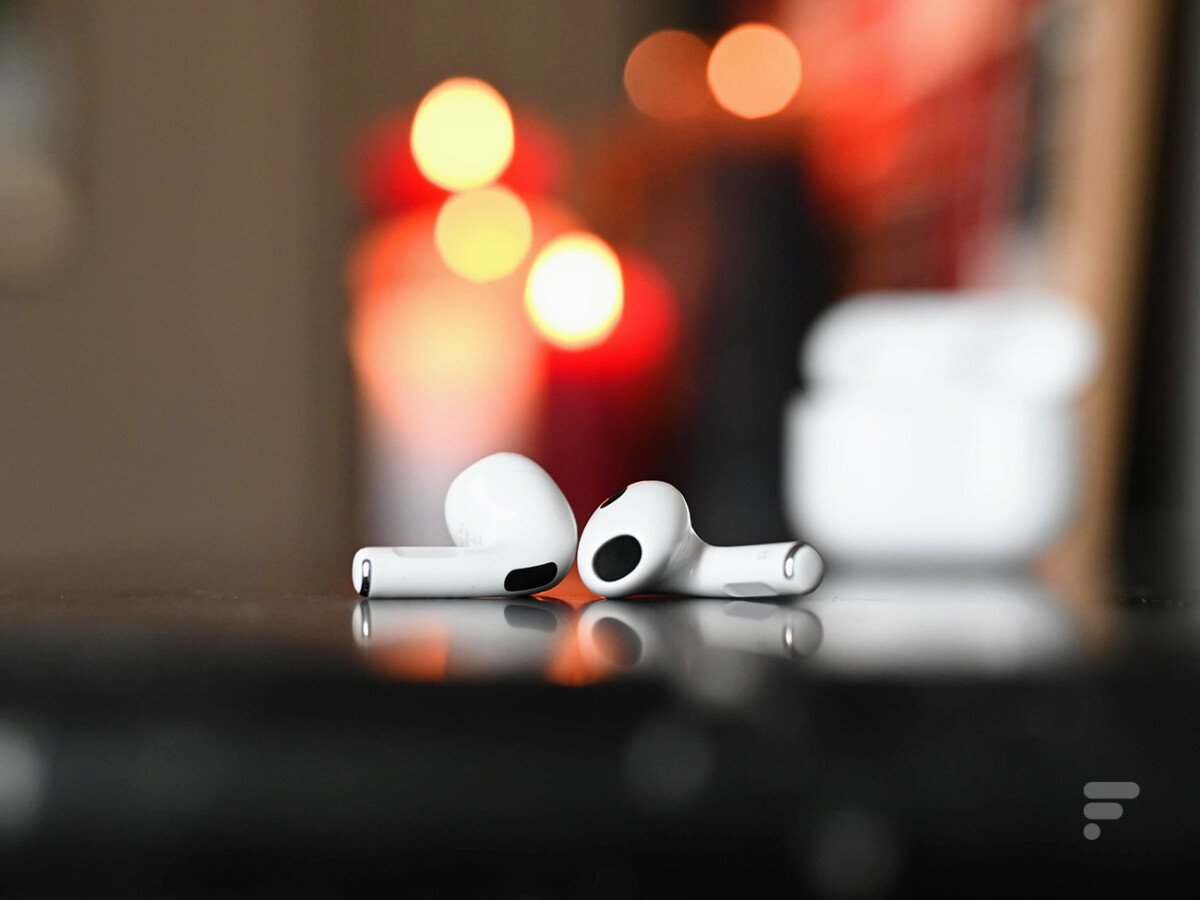
Apple’s AirPods 3 // Source: Frandroid
To refer more precisely to audible frequencies, the sound spectrum is divided into octave bands. These bands are designated by their central frequency: the first covers the low frequencies from 25 to 40 Hz, with 31.5 Hz in the middle. Over the entire audible spectrum, from 20 Hz to 20,000 Hz, we thus have the octave bands of 31.5 Hz, 63 Hz, 125 Hz, 250 Hz, 500 Hz, 1 kHz, 2 kHz, 4 kHz, 8 kHz and 16 kHz.
These are frequently the bands offered in the equalizers of companion apps for Bluetooth headphones and earphones.
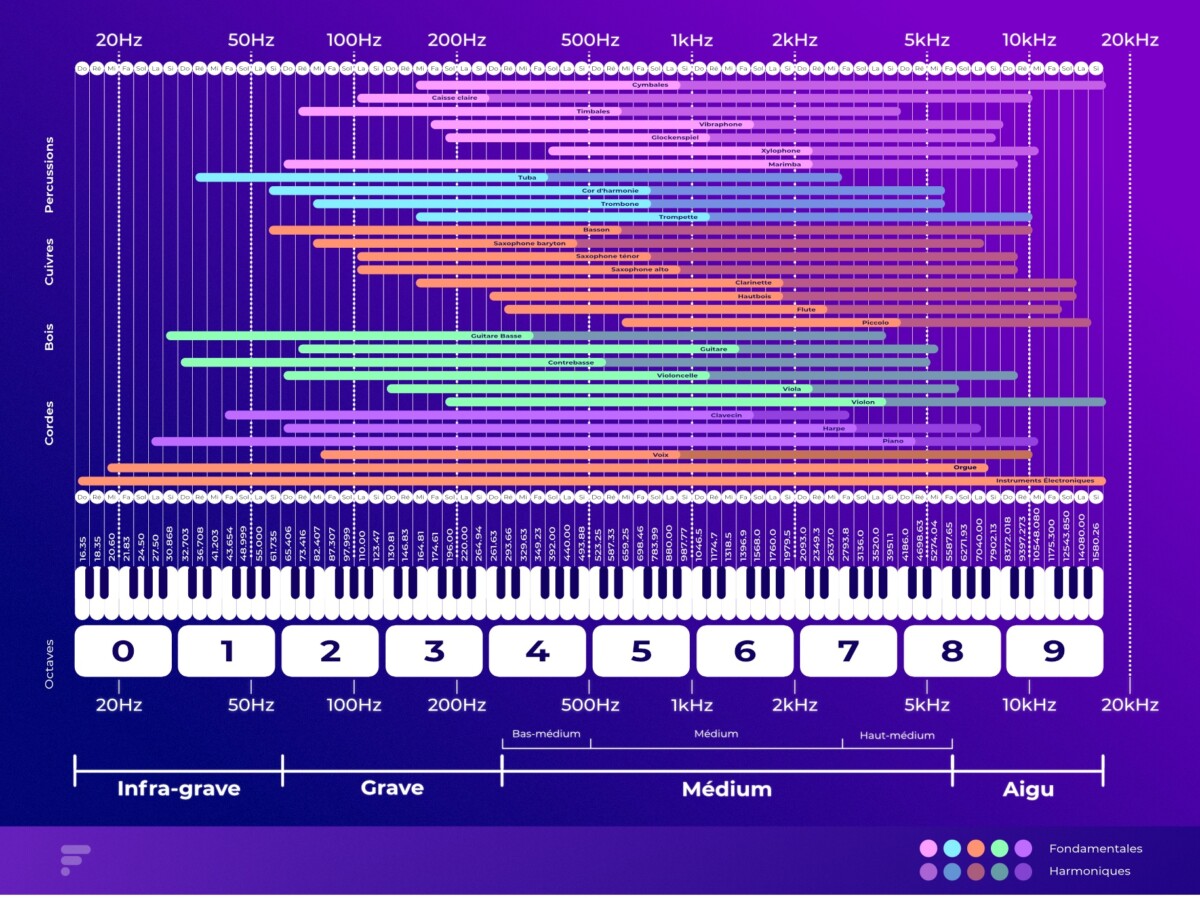
The frequencies used for different instruments, from 20 to 2000 Hz // Source: Frandroid
To find out what each frequency range corresponds to, we can turn to different musical instruments, as seen above. Each instrument produces sounds of varying frequencies, depending on the note that is played and each corresponds to a so-called fundamental frequency, expressed in Hertz.
However, by unfolding in the air, the note played will be enriched with additional frequencies called harmonics. To understand the principle, just imagine the impact of a drop of rain on the surface of the water. The impact produces a first wave (the fundamental frequency) then a series of smaller and smaller waves (the harmonic frequencies). In air, the sound wave unfolds in the same way and the fundamental frequency of a strummed string is accompanied by harmonic frequencies whose value doubles up to six times.
The frequency response of headphones and earphones
The transducers in headphones and earphones are designed to reproduce the widest possible frequency range. We talk about frequency response or bandwidth. To express it, the manufacturers indicate the lowest reproduced frequency, as well as the highest, very often 20 Hz (low frequency) to 20 kHz (high frequency). However, this information does not tell much, because it does not make it possible to know whether all the notes are reproduced with the same intensity or, if not, what the differences in level are. But that is what matters.
To know precisely the frequency response of headphones or earphones, it is necessary to carry out a measurement. To do this, we use a dummy equipped with calibrated microphones. A helmet is fitted to the dummy’s head, while earphones are inserted into its ears (where the microphones are located).
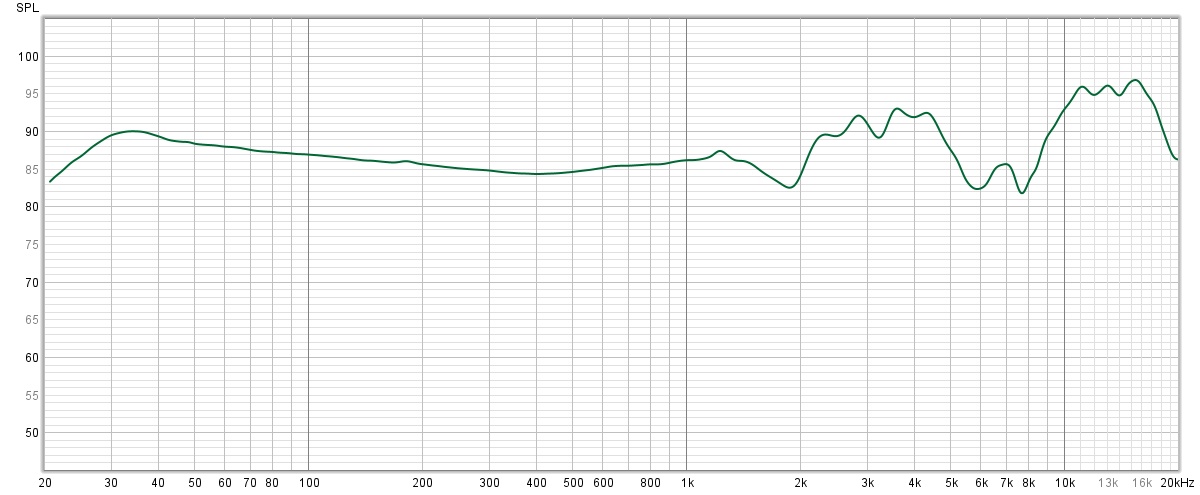
A W-shaped headphone response curve, with three peaks identified in parts of the low, mid and high registers.
The response curve above has a W profile, this means that each of the three frequency registers is reproduced with a volume peak. In this case, the infra-bass (from 30 to 40 Hz) is in front, as well as the high-medium (from 2500 to 4500 Hz) and the extreme treble. A helmet with such a curve will produce a balanced and generous sound, often catchy.
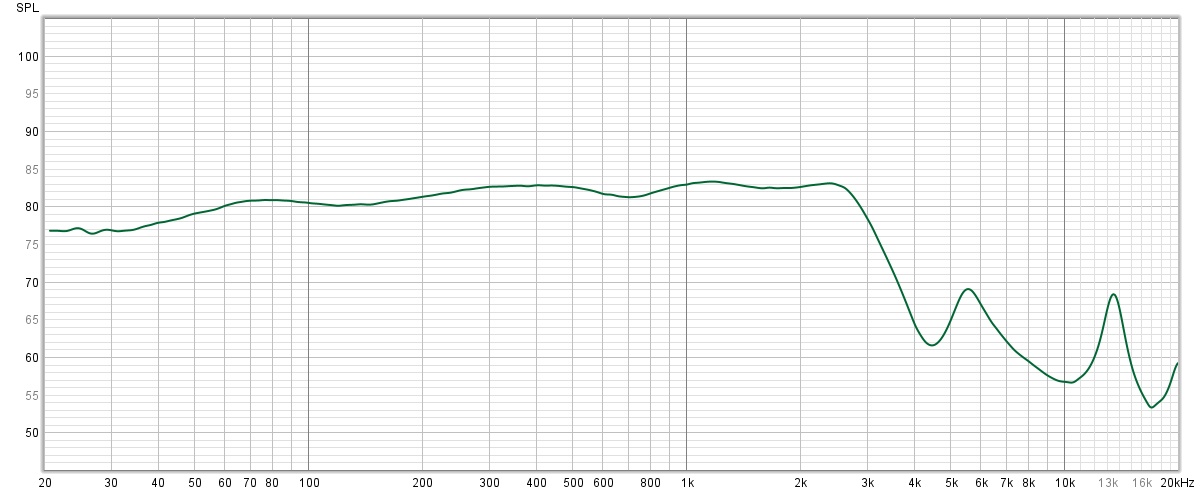
A descending response curve (treble set back).
The response curve above is said to be descending, with a fairly significant setback of the high frequencies. This type of curve generally results in a dry, even austere reproduction, especially when the bass is also set back.
What is a good response curve?
One can legitimately think that the ideal response curve for a loudspeaker, headphones or earphones must be linear, that is to say that the restitution of all the frequencies must be done at an equivalent volume, that is to say with a curve the as flat as possible. However, this is neither possible nor desirable. A response curve is by definition uneven, because the sound before reaching the heart of the ear encounters various obstacles — shell and earmold for an earphone, surfaces of the listening room for a loudspeaker, pinna of the ear, canal auditory — and is thus disturbed. In addition, all loudspeakers have their own mechanical specificities which bring colorations (peaks or troughs) to certain portions of the audio spectrum. In short, all observable accidents on the curves above are therefore inevitable.
the mid frequencies are strongly accentuated
Next, a linear curve is not desirable, because our ear is more sensitive to certain frequencies than to others. Concretely, the low frequencies and the high frequencies are perceived below their real intensity and this phenomenon is even more marked when the music is of low intensity. On the other hand, the mid frequencies, particularly those between 2 and 4 kHz, are strongly accentuated. The explanation is simple: the ear canal naturally vibrates with these frequencies and amplifies them mechanically.
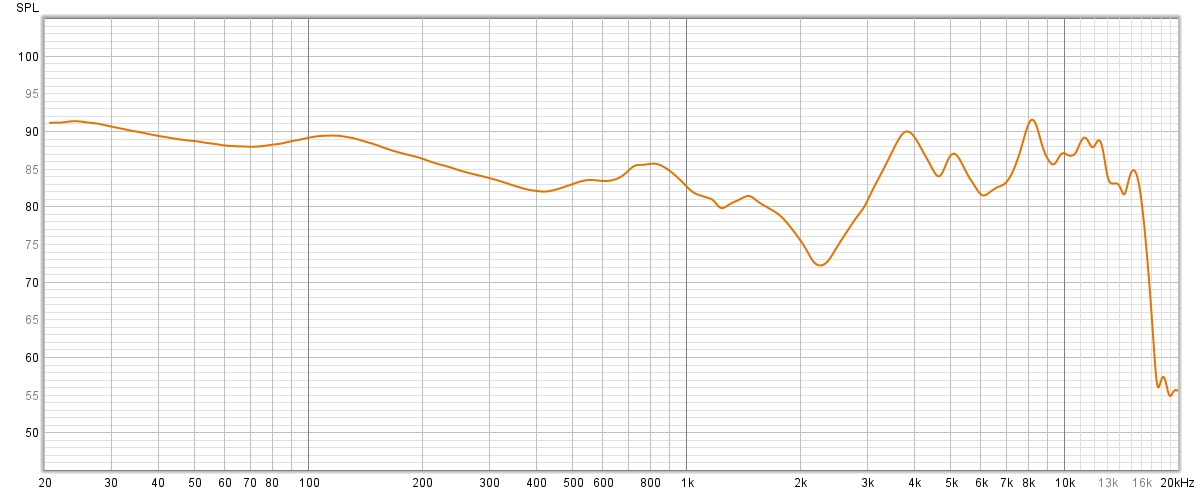
The Sony WH-1000XM4 is not very generous in high-mids
Therefore, a response curve that would give a relative impression of balance should be generous in the low and high frequencies, but moderate in the midrange (especially in the upper midrange, from 2 to 4 kHz). This is called a physiological curve. The yellow Sony WH-1000XM4 curve above is a good example.
The equalizer to correct the response curve of headphones
If you don’t quite like the sound signature of the headphones or earphones you’re using, it’s possible to change it quite easily. Most Bluetooth headphones or earphones work with an app, which probably includes an equalizer. To effectively correct the sound of Bluetooth headphones, it is this app that should be preferred, because it directly controls the processor of the headphones.
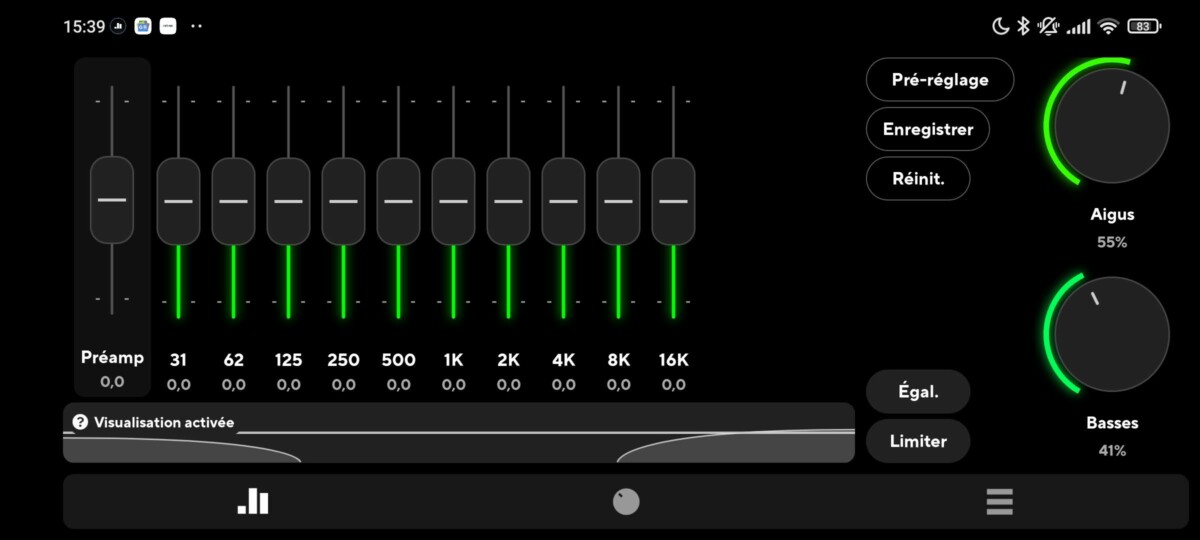
The Poweramp equalizer Android app allows you to correct the sound signature of headphones or earphones.
Otherwise, you have to turn to a third-party application to equalize the sound on the smartphone. There are many of them and the best are those that offer the most adjustment frequencies. We can for example cite the music applications that you use on a daily basis, or directly the audio settings of your smartphone.
Finally, note that an equalizer makes it possible to correct minor faults, but not to transfigure the behavior of headphones or earphones.
To follow us, we invite you to download our Android and iOS application. You can read our articles, files, and watch our latest YouTube videos.

